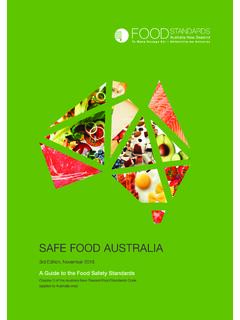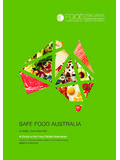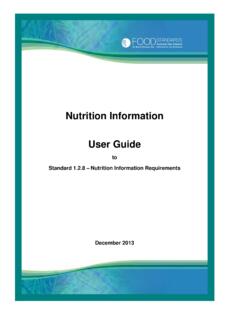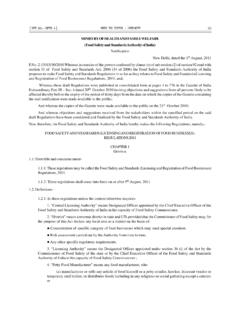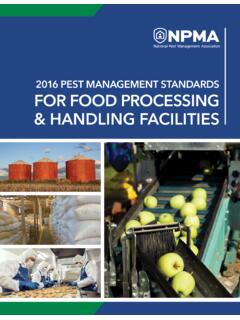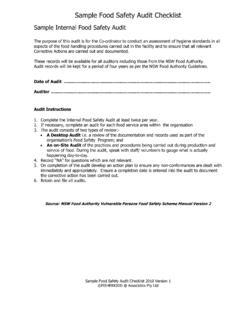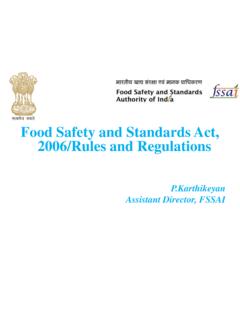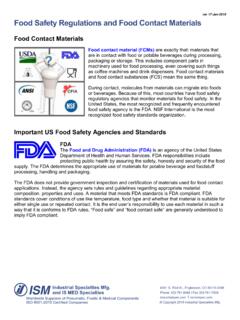Transcription of Standard 3.2.2 Food Safety Practices and General …
1 AUSTRALIA NEW ZEALAND food standards CODECHAPTER 3 (AUSTRALIA ONLY) Standard Safety Practicesand General RequirementsA GUIDE TO THE food Safety STANDARDSSECOND EDITION, JANUARY 2001 AUSTRALIA NEW ZEALAND food AUTHORITYSAFE food AUSTRALIA21 Standard NEW ZEALAND food standards CODECHAPTER 3 (AUSTRALIA ONLY) Standard Safety Practicesand General Requirements(Australia only)PurposeThis Standard sets out specific requirements for food businesses and food handlers that, ifcomplied with, will ensure food does not become unsafe or Standard specifies process control requirements to be satisfied at each step of the foodhandling process. Some requirements relate to the receipt, storage, processing, display,packaging, distribution disposal and recall of food .
2 Other requirements relate to the skillsand knowledge of food handlers and their supervisors, the health and hygiene of foodhandlers, and the cleaning, sanitising, and maintenance of premises and 1 Interpretation and application1 Interpretation2 Application of this StandardDivision 2 General requirements3 food handling skills and knowledge4 NotificationDivision 3 food handling controls5 food receipt6 food storage7 food processing8 food display9 food packaging10 food transportation11 food disposal12 food recallStandard NEW ZEALAND food AUTHORITYSAFE food AUSTRALIASTANDARD GUIDE TO THE food Safety STANDARDSSECOND EDITION, JANUARY 2001 Division 4 Health and hygiene requirementsSubdivision 1 Requirements for food handlers13 General requirement14 Health of food handlers15 Hygiene of food handlersSubdivision 2 Requirements for food businesses16 Health of persons who handle food duties of food businesses17 Hygiene of food handlers duties of food businesses18 General duties of food businessesDivision 5 Cleaning.
3 Sanitising and maintenance19 Cleanliness20 Cleaning and sanitising of specific equipment21 MaintenanceDivision 6 Miscellaneous22 Temperature measuring devices23 Single use items24 Animals and pests25 Alternative methods of complianceClausesDivision 1 Interpretation and application1 InterpretationIn this Standard , unless the contrary intention appears carrier of a food -borne disease does not include a person who is a carrier ofStaphylococcus means an infected skin lesion or discharges from the ear, nose or conditions means conditions under which certain food may berequired to be stored including temperature, humidity, lightingconditions and disease means a disease that is likely to be transmitted throughconsumption of contaminated Safety program means a program set out in a written document retained atthe food premises of the food business, including records of complianceand other related action, that:(a)systematically identifies the potential hazards that may bereasonably expected to occur in all food handling operations ofthe food business.
4 AUSTRALIA NEW ZEALAND food AUTHORITYSAFE food AUSTRALIA23 Standard NEW ZEALAND food standards CODECHAPTER 3 (AUSTRALIA ONLY)(b)identifies where, in a food handling operation, each hazardidentified under paragraph (a) can be controlled and the means ofcontrol;(c)provides for the systematic monitoring of those controls;(d)provides for appropriate corrective action when that hazard, oreach of those hazards, is found not to be under control;(e)provides for the regular review of the program by the foodbusiness to ensure its adequacy; and(f)provides for appropriate records to be made and kept by the foodbusiness demonstrating action taken in relation to, or incompliance with, the food Safety does not include partly hazardous food means food that has to be kept at certain temperaturesto minimise the growth of any pathogenic micro-organisms that may bepresent in the food or to prevent the formation of toxins in the , in relation to food , means activity conducted to prepare food for saleincluding chopping, cooking, drying, fermenting, heating, pasteurising,thawing and washing.
5 Or a combination of these food means food that is ordinarily consumed in the same state as thatin which it is sold and does not include nuts in the shell and whole, rawfruits and vegetables that are intended for hulling, peeling or washing bythe means diarrhoea, vomiting, sore throat with fever, fever or control means maintaining food at a temperature of:(a)5 C, or below if this is necessary to minimise the growth ofinfectious or toxigenic micro-organisms in the food so that themicrobiological Safety of the food will not be adversely affected forthe time the food is at that temperature; or(b)60 C or above; or(c)another temperature if the food business demonstrates thatmaintenance of the food at this temperature for the period oftime for which it will be so maintained, will not adversely affectthe microbiological Safety of the of this StandardThis Standard applies to all food businesses and food handlers in Australia in accordancewith Standard (Interpretation and Application).
6 Standard NEW ZEALAND food AUTHORITYSAFE food AUSTRALIASTANDARD GUIDE TO THE food Safety STANDARDSSECOND EDITION, JANUARY 2001 Editorial note: food businesses that operate from a farm, vineyard, orchard or aquaculturefacility should refer to the definition of food business in Standard todetermine if they have to comply with this Standard . If they are involved in thesubstantial transformation of food or the sale or service of food directly to thepublic then they must comply with this 2 General requirements3 food handling skills and knowledge(1)A food business must ensure that persons undertaking or supervising foodhandling operations have:(a)skills in food Safety and food hygiene matters; and(b)knowledge of food Safety and food hygiene matters,commensurate with their work activities.
7 (2)Subclause (1) does not apply to a food business in relation to persons undertakingfood handling operations for fundraising events, that is, events:(a)that raise funds solely for community or charitable causes and not forpersonal financial gain; and(b)at which only food is sold that is not potentially hazardous or which is tobe consumed immediately after thorough (1)A food business must, before the food business commences any food handlingoperations, notify the appropriate enforcement agency of the following information:(a)contact details for the food business including the name of the foodbusiness and the name and business address of the proprietor of the foodbusiness;(b)the nature of the food business; and(c)the location of all food premises of the food business that are within thejurisdiction of the enforcement agency.
8 (2)When complying with subclause (1), the proprietor of the food business mustanswer all questions asked by the appropriate enforcement agency in relation to the matterslisted in subclause (1) in the form approved from time to time by the relevant authorityunder the Act.(3)The food business must notify the appropriate enforcement agency of any proposedchange to the information specified in subclause (1) before the change NEW ZEALAND food AUTHORITYSAFE food AUSTRALIA25 Standard NEW ZEALAND food standards CODECHAPTER 3 (AUSTRALIA ONLY)(4)A food business that exists at the time of the commencement of this Clause mustprovide the appropriate enforcement agency with the information specified in subclause (1)within three months of the commencement of this 3 food handling controls5 food receipt(1)
9 A food business must take all practicable measures to ensure it only accepts foodthat is protected from the likelihood of contamination.(2)A food business must provide, to the reasonable satisfaction of an authorised officerupon request, the following information relating to food on the food premises:(a)the name and business address in Australia of the vendor, manufacturer orpacker or, in the case of food imported into Australia, the name andbusiness address in Australia of the importer; and(b)the prescribed name or, if there is no prescribed name, an appropriatedesignation of the food .(3)A food business must, when receiving potentially hazardous food , take allpracticable measures to ensure it only accepts potentially hazardous food that is at atemperature of:(a)5 C or below; or(b)60 C or above,unless the food business transporting the food demonstrates that the temperature of thefood, having regard to the time taken to transport the food , will not adversely affect themicrobiological Safety of the food .
10 (4)A food business must, when receiving potentially hazardous food , take allpracticable measures to ensure that food which is intended to be received frozen, is frozenwhen it is storage(1)A food business must, when storing food , store the food in such a way that:(a)it is protected from the likelihood of contamination; and(b)the environmental conditions under which it is stored will not adverselyaffect the Safety and suitability of the food .(2)A food business must, when storing potentially hazardous food :(a)store it under temperature control; and(b)if it is food that is intended to be stored frozen, ensure the food remainsfrozen during NEW ZEALAND food AUTHORITYSAFE food AUSTRALIASTANDARD GUIDE TO THE food Safety STANDARDSSECOND EDITION, JANUARY 20017 food processing(1)A food business must:(a)take all practicable measures to process only safe and suitable food ; and(b)when processing food :(i)take all necessary steps to prevent the likelihood of food beingcontaminated.
